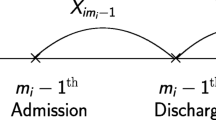Abstract
In this article, clustered recurrent gap time is investigated. A marginal additive hazards model is proposed without specifying the association of the individuals within the same cluster. The relationship among the gap times for the same individual is also left unspecified. An estimating equation-based inference procedure is developed for the model parameters, and the asymptotic properties of the resulting estimators are established. In addition, a lack-of-fit test is presented to assess the adequacy of the model. The finite sample behavior of the proposed estimators is evaluated through simulation studies, and an application to a clinic study on chronic granulomatous disease (CGD) is illustrated.
Similar content being viewed by others
References
Gail M H, Santner T J, and Brown C C, An analysis of comparative carcinogenesis experiments based on multiple times to tumor, Biometrics, 1980, 36: 255–266.
Huang Y and Chen Y Q, Marginal regression of gaps between recurrent events, Lifetime Data Analysis, 2003, 9: 293–303.
Schaubel D E and Cai J, Regression analysis for gap time hazard functions of sequentially ordered multiplivariate failure time data, Biometrika, 2004, 91: 291–303.
Strawderman R L, The accelerated gap times model, Biometrika, 2005, 92: 1299–1315.
Luo X and Huang C Y, Analysis of recurrent gap time data using the weighted risk-set method and the modified within-cluster resampling method, Statistics in Medicine, 2011, 30: 301–311.
Darlington G A and Dixon S N, Event-weighted proportional hazards modelling for recurrent gap time data, Statistics in Medicine, 2013, 32: 124–130.
Chang S H, Estimating marginal effects in accelerated failure time models for serial sojourn among repeated event, Lifetime Data Analysis, 2004, 10: 175–190.
Sun L, Park D H, and Sun J, The additive hazards model for recurrent gap times, Statistica Sinica, 2006, 16: 919–932.
Lin D Y, Sun W, and Ying Z, Nonparametric estimation of the gap time distribution for serial events with censored data, Biometrika, 1999, 86: 59–70.
Wang M C and Chang S H, Nonparametric estimation of a recurrent survival function, Journal of the American Statistical Association, 1999, 94: 146–153.
Peffna E A, Strawderman R, and Hollander M, Nonparametric estimation with recurrent event data, Journal of the American Statistical Association, 2001, 96: 1299–1315.
Du P, Nonparametric modeling of the gap time in recurrent event data, Lifetime Data Analysis, 2009, 15: 256–277.
Cai T, Wei L, and Wilcox M, Semiparametric regression analysis for clustered failure time data, Biometrika, 2000, 87: 867–878.
Lu S and Wang M, Marginal analysis for clustered failure time data, Lifetime Data Analysis, 2005, 11: 61–79.
Cai T, Cheng S, and Wei L, Semiparametric mixed-effects models for clustered failure time data, Journal of the American Statistical Association, 2002, 97: 514–522.
Cai J and Zeng D, Additive mixed effect model for clustered failure time data, Biometrics, 2011, 67: 1340–1351.
Yu Z, Lin X, and Tu W, Semiparametric frailty models for clustered failure time data, Biometrics, 2012, 68: 429–436.
Gauran I and Barrios E, Nonparametric model of clustered customer survival data, Communications in Statistics-Simulation and Computation, 2017, 46: 603–618.
Chen L, Feng Y, and Sun J, Regression analysis of clustered failure time data with informative cluster size under the additive transformation models, Lifetime Data Analysis, 2017, 23(4): 651–670.
Chiou S, Kang S, and Yan J, Semiparametric accelerated failure time modeling for clustered failure times from stratified sampling, Journal of the American Statistical Association, 2015, 110: 621–629.
Schaubel D and Cai J, Analysis of clustered recurrent event data with application to hospitalization rates among renal failure patients, Biostatistics, 2005, 6: 404–419.
He S, Wang F, and Sun L, A semiparametric additive rates model for clustered recurrent event data, Acta Mathematicae Applicatae Sinica, 2003, 29: 55–62.
Liu D, Schaubel D E, and Kalbfleisch J D, Computationally efficient marginal models for clustered recurrent event data, Biometrics, 2012, 68: 637–647.
Liang K Y and Zeger S L, Longitudinal data analysis using generalized linear models, Biometrika, 1986, 73: 13–22.
Lin D Y, Wei L J, Yang L, et al., Semiparametric regression for the mean and rate function of recurrent events, Journal of the Royal Statistical Society, Series B, 2000, 69: 711–730.
Fleming T R and Harrington D P, Counting Processes and Survival Analysis, Wiley, New York, 1991.
Sun L, Tong X, and Zhou X, A class of Box-Cox transformation models for recurrent event data, Lifetime Data Analysis, 2011, 17: 280–301.
Author information
Authors and Affiliations
Corresponding author
Additional information
This research was supported by the National Natural Science Foundation of China under Grant Nos. 11501037, 11771431, and 11690015.
This paper was recommended for publication by Editor YU Zhangsheng.
Rights and permissions
About this article
Cite this article
Kang, F., Sun, L. & Cheng, X. An Additive Hazards Model for Clustered Recurrent Gap Times. J Syst Sci Complex 31, 1377–1390 (2018). https://doi.org/10.1007/s11424-018-6329-3
Received:
Revised:
Published:
Issue Date:
DOI: https://doi.org/10.1007/s11424-018-6329-3




